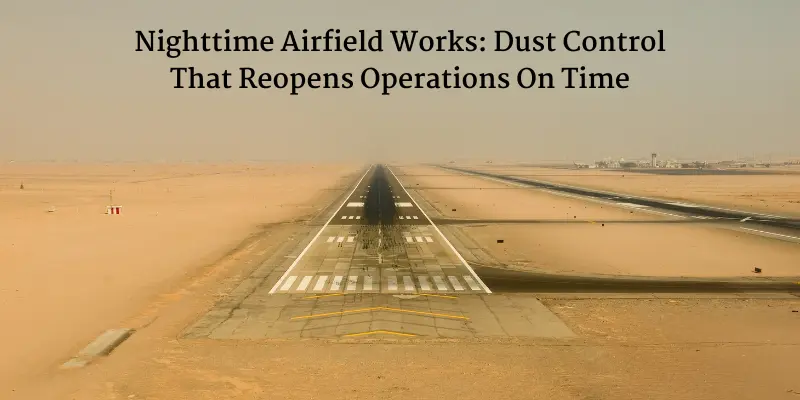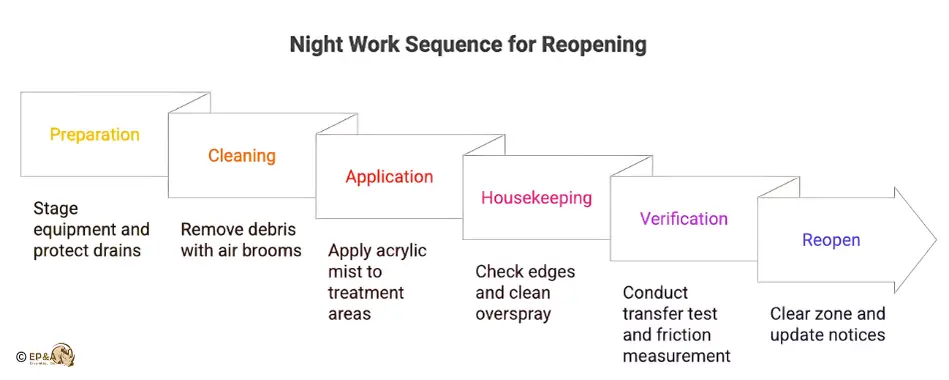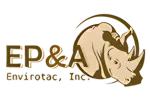
September 23, 2025
Airports live and breathe by schedules. When construction happens overnight, crews have just a few hours to finish work, clean up, and hand the surface back before the first wave of departures. Dust from shoulders, haul routes, and stockpiles may seem minor, but it can affect visibility, add to Foreign Object Debris (FOD) risk, and spark community complaints. The challenge is not just controlling dust—it’s proving, with evidence, that the surface is safe and ready to reopen.
This guide explains a simple, standards-aligned sequence for nighttime dust control. At each stage, you’ll see how to prevent delays and how to verify results. If you’d like this adapted to your airport’s soils, traffic, and schedule, you can request a tailored plan for our comprehensive range of dust control products
.Why Dust at Night Matters
During the day, dust problems can be spotted and corrected before they reach the runway. At night, there’s little room for error. Loose fine particles kicked up by haul trucks or rotor-wash can move onto pavement textures, just when the morning push begins. Dust isn’t only a visibility issue—it can introduce FOD into jet engines and leave airport operations teams with no time to recover before flights resume.
FAA guidance, such as AC 150/5370-2G: Operational Safety on Airports During Construction and AC 150/5210-24A: FOD Management, make it clear that dust control is part of safe operations, not just housekeeping. Internationally, ICAO Annex 14: Aerodrome Design and Operations also calls for strict management of loose materials near pavements.
Defining Dust Control and Setting Boundaries
For airports, a dust palliative is a material applied to soil to keep fine particles from becoming airborne. In this context, the material is an acrylic, water-based binder. It’s designed for non-friction areas—unpaved shoulders, haul routes, and stockpiles—not for active runways or taxiways. If any edge near pavement requires stabilization, it gets special treatment and verification.
Health and environmental standards provide a benchmark for success. The U.S. Environmental Protection Agency (EPA) sets a 24-hour PM₁₀ standard of 150 µg/m³, while the World Health Organization (WHO) recommends a stricter 45 µg/m³. Even if you’re not running a full compliance program overnight, these figures frame what “good” looks like at the fence line.
Where to Treat During Night Works
Not every unpaved surface needs immediate treatment. The real risks come from areas exposed to blast forces or repeated traffic:
- Shoulders next to runways or taxiways where engines pass close.
- Blast zones behind thresholds or power-up areas.
- Haul routes where trucks cycle in and out during the shift.
- Stockpiles or staging pads that winds can easily disturb.
By focusing on these “high-impact” zones, crews save time and materials while targeting the dust sources that threaten safe reopenings.
The Night Work Sequence
A successful operation isn’t about promises on minutes—it’s about a rhythm crews can follow under pressure. The sequence below is a best-practice framework tied to reopening time:
- 180–120 minutes before reopening: Preparation. Stage equipment, aim lighting carefully, and protect drains and markings.
- 120–90 minutes: Cleaning. Use air brooms and vacuum sweepers to remove loose debris, especially at edges.
- 90–45 minutes: Application. Apply a light mist of acrylic on treatment areas. Rates are calculated in gallons per square yard (gsy) and litres per square metre (L/m²), adjusted for soil and traffic. Avoid pooling or overspray onto pavement textures.
- 45–30 minutes: Housekeeping. Check edges under angled light; any sheen means re-sweeping. Clean overspray off markings immediately.
- 30–10 minutes: Verification. Run a simple transfer test on a clean mat—no residue means the treatment has cured sufficiently (internal QC best-practice; not a formal FAA/ASTM method). If a paved edge was touched, add a quick friction measurement with your approved device.
At reopen: clear the zone, confirm checks, and update Notice to Airmen (NOTAMs) or ATIS as required.

Applying Acrylic Dust Control Polymers Safely
At night, the mantra is fog, don’t flood. A fine mist binds surface fines and minimizes surface film, creating a slickness. For edges near pavement, use the lowest effective rate, mask markings, and sweep immediately after application. Instead of heavy one-off doses, light re-treatments on consecutive nights give better results and safer hand-backs.
Verifying Friction Where It Counts
Airfield safety hinges on maintaining friction. If a treated edge is close to a pavement surface, a friction check is required before release. Using standards such as ASTM E1911 (Dynamic Friction Tester) or ASTM E274 (Locked-Wheel Skid), airports can confirm the coefficient of friction (μ) remains above their program limit. Many aviation chemicals are also tested for aircraft materials compatibility under Boeing BSS7432; this is separate from pavement friction testing (e.g., ASTM E1911/E274).
Building a Reopening Package
Proof matters. Before handing back the surface, document key checks in a structured way. A reopening package typically includes:
| Reopening Package Item | Verification Step | Logged As… |
|---|---|---|
| FOD sweep counts | Final sweeper pass recorded | Ops log |
| Edge/interface photos | Spot check at high-light angle | Photo file |
| Friction readings (if req) | ASTM E1911/E274 devices | Log sheet |
| PM readings (start + end) | Downwind fence-line sensor | Air log |
| Supervisor sign-off | Time + initials | Checklist sheet |
This package gives Airport Ops a record they can file and defend if needed.
Fence-Line Checks Made Simple
For transparency and not just compliance, use a portable downwind sensor. Take a reading at the start and another at the end, and note the wind. Even two data points, supported by photos, show good faith and transparency.
Environmental and Stormwater Guardrails
Dust control shouldn’t create new problems. Crews keep spray away from drains and markings, use inlet socks where needed, and avoid puddles. Equipment lines are rinsed promptly after use, and protections are logged as part of the reopen package.
Rotorcraft and Helipads
Hospitals and public-safety helipads face brownout risks when rotor-wash hits untreated soils. Night work sequences are similar—clean, light mist application, simple checks—but with an added first-light inspection. Keeping the touchdown pad itself clear and focusing on the perimeter is the safest approach.
Planning for Contingencies
Even with preparation, things go wrong. Light rain after application may require re-sweeping and delaying release until the transfer test passes (per manufacturer’s TDS and site conditions). If an emergency aircraft returns mid-work, crews clear an idle-power corridor and shut down equipment in that path first. A sudden PM spike should prompt an immediate check of wind/sensor status, a quick clean-up/sweep, and a follow-up reading; escalate if levels remain elevated, recur, or a visible plume is present. Overspray on markings has a clear, clean-back order: wipe, mild water wash, sweep, and verify again.
Conclusion
Night construction should leave no margin for error. A well-timed sequence, controlled acrylic application, and simple verification steps give airports the confidence to reopen on time and without new hazards. If your next night-work project needs dust control that proves itself at dawn, request a tailored plan.
Applications - Dust Control & Soil Stabilization Products


Leave a Reply